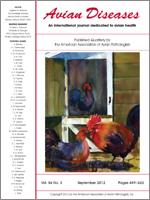In a previous study, we found clear differences in pathogenicity and response to vaccination against H5N1 highly pathogenic avian influenza (HPAI; HA clade 2.3.4) between Pekin (Anas platyrhynchos var. domestica) and Muscovy (Cairina moschata) ducks vaccinated using a commercial inactivated vaccine (Re-1). The objective of the present study was to further investigate the pathogenicity of H5N1 HPAI viruses in different species of ducks by examining clinical signs and innate immune responses to infection with a different strain of H5N1 HPAI virus (HA clade 1) in two domestic ducks, Pekin and Muscovy, and one wild-type duck, mallard (Anas platyrhynchos). Protection conferred by vaccination using the Re-1 vaccine against infection with this virus was also compared between Pekin and Muscovy ducks. Differences in pathogenicity were observed among the virus-infected ducks, as the Muscovy ducks died 2 days earlier than did the Pekin and mallard ducks, and they presented more-severe neurologic signs. Conversely, the Pekin and mallard ducks had significantly higher body temperatures at 2 days postinfection (dpi) than did the Muscovy ducks, indicating possible differences in innate immune responses. However, similar expression of innate immune-related genes was found in the spleens of virus-infected ducks at this time point. In all three duck species, there was up-regulation of IFN-α, IFN-γ, IL-6, CCL19, RIG-I, and MHC class I and down-regulation of MHC class II, but variable expression of IL-18 and TLR7. As in our previous study, vaccinated Muscovy ducks showed less protection against virus infection than did Pekin ducks, as evidenced by the higher mortality and higher number of Muscovy ducks shedding virus when compared to Pekin ducks. In conclusion, infection with an H5N1 HPAI virus produced a systemic infection with high mortality in all three duck species; however, the disease was more severe in Muscovy ducks, which also had a poor response to vaccination. The differences in response to virus infection could not be explained by differences in the innate immune responses between the different types of ducks when examined at 2 days dpi, and earlier time points need to be evaluated.
How to translate text using browser tools
1 September 2012
Differences in Pathogenicity, Response to Vaccination, and Innate Immune Responses in Different Types of Ducks Infected with a Virulent H5N1 Highly Pathogenic Avian Influenza Virus from Vietnam
Caran Cagle,
Jamie Wasilenko,
Sean C. Adams,
Carol J. Cardona,
Thanh Long To,
Tung Nguyen,
Erica Spackman,
David L. Suarez,
Diane Smith,
Eric Shepherd,
Jason Roth,
Mary J. Pantin-Jackwood
ACCESS THE FULL ARTICLE

Avian Diseases
Vol. 56 • No. 3
September 2012
Vol. 56 • No. 3
September 2012
ducks
H5N1 type
highly pathogenic avian influenza
innate immunity
pathogenicity
vaccination




